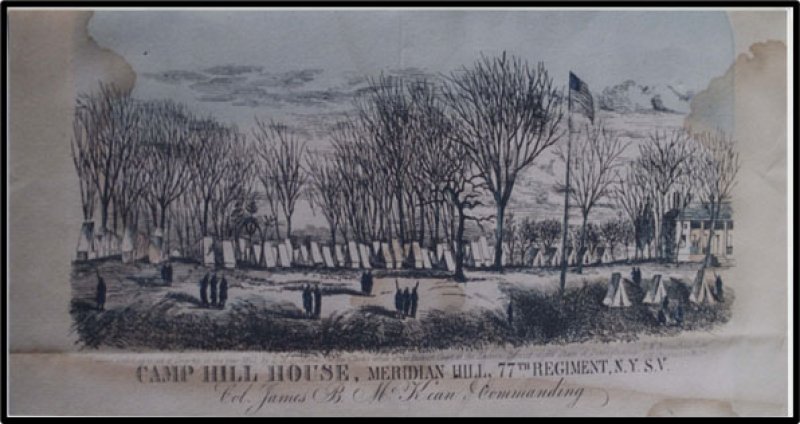On Nov. 23, 1861, hundreds of men dressed in the blue uniforms of the Union Army mustered in Saratoga Springs. Hailing from villages and towns across Saratoga County as well as from Fulton and Essex counties, the soldiers of the newly formed 77th New York State Volunteer Infantry Regiment were heading off to war.
Nearly seven months earlier, on April 12, secessionist forces had opened fire on the federal government’s Fort Sumter in South Carolina’s Charleston Harbor. The decades-long debate between the Northern and Southern states over extending slavery into western territories and new states had degenerated into a shooting war.
In Saratoga County, as elsewhere in communities across the North, men were answering President Abraham Lincoln’s call for tens of thousands of volunteers to quell the rebellion in the South. James B. McKean, a local lawyer elected to Congress in 1858, led the effort to raise a regiment from a three-county area in northeastern New York.
“Traitors in arms seek to overthrow our constitution and to seize our capital,” McKean wrote in an appeal to his constituents published in August 1861. “Let us go and help to defend them. … Let farmers, mechanics, merchants, and all classes, for the liberties of all are at stake, aid in organising (sic) companies. I will cheerfully assist in procuring the necessary papers.”
Dozens of infantry regiments already had been organized across New York State and mustered into the Union Army. Numeric regimental designations in each Northern state were assigned in chronological order. The new Saratoga outfit was supposed to become New York’s 45th Volunteer Infantry Regiment but was instead granted permission to be designated the 77th Regiment, a symbolic tribute to the Revolutionary War’s Battles of Saratoga fought on Bemis Heights in September and October 1777.
Just days after mustering in Saratoga Springs on Thanksgiving Day in 1861, the 77th – known as the Bemis Heights Regiment -- boarded trains and headed to New York City. There the 700-plus soldiers were honored by former Saratogians who presented a regimental flag featuring a depiction of British General John Burgoyne surrendering after the Saratoga battles.
By New Year’s Day 1862, the regiment was encamped at Meridian Hill in Washington, D.C., joining thousands of other Union volunteers encamped in and around the city ahead of the upcoming spring campaign against the Confederate army in neighboring Virginia. That spring, the regiment saw its first action at the siege of Yorktown, the first of many it would fight on the Old Dominion’s soil.
The 77th Regiment fought in the Battle of Antietam at Sharpsburg, Maryland, on Sept. 17, 1862, when Confederate General Robert E. Lee’s Army of Northern Virginia and Union troops clashed in what would turn out to be the single bloodiest day in American history. Total casualties for both sides topped 22,000 killed, wounded and missing. The 77th suffered 11 killed and 21 wounded.
In early May 1863, the 77th Regiment was among the leading Union units that assaulted the rebel positions on the high ground overlooking Fredericksburg, Virginia. Mowed down by defenders firing from behind a stone wall atop Marye’s Heights, the Northerners suffered nearly 1,100 casualties. Among them was Capt. Luther M. Wheeler, one of the regiment’s most admired officers. Advancing out ahead of his troops, Wheeler was shot in the torso. Carried to a temporary hospital by two of his soldiers, Wheeler died of his wounds early the next morning.
Two months later, the 77th was among the Union forces confronting Lee’s army at Gettysburg, Pennsylvania. The regiment was held in reserve, sparring it from the three-day bloodletting that resulted in more than 50,000 casualties between Confederate and Union forces, including more than 7,000 killed.
As fierce as the fighting was in 1862 and ’63, it would get even worse in 1864. Lincoln had appointed General Ulysses S. Grant as overall commander of the Union Army that March, and the Yankee hero of the war’s Western Theater brought a relentless approach with him when he came east. Unlike his predecessors, Grant wouldn’t retreat after every battle, whether it was won or lost. Instead, starting in May, the West Point graduate kept his army on the offensive following every engagement, resulting in a series of battles across eastern Virginia that left tens of thousands of dead, wounded and missing soldiers in their wake.
The 77th participated in most of those clashes, from The Wilderness and Spotsylvania Court House in May to Cold Harbor the next month. Spotsylvania, fought over multiple days, would turn out to be the 77th Regiment’s bloodiest battle, with 30 soldiers killed, 56 wounded and another 21 listed as missing in action. The regiment would lose dozens of other soldiers before the war’s deadliest year was over.
As the war entered its fourth year, there was hope on the Union side that the Confederate army was on its last legs. Grant had besieged Petersburg, Virginia, the key supply center for the Confederate capital in nearby Richmond, while General William Tecumseh Sherman’s army had marched its way through Georgia to the sea, gutting the Confederate war machine’s infrastructure and materiel support systems for the remainder of the war.
In early April 1865, the 77th was there when the siege of Petersburg ended, then participated in one of the final battles of the war, fought at Sailor’s Creek in Virginia on April 6. Three days later, Lee surrendered to Grant at Appomattox Court House. The 77th Regiment was among the Union outfits bivouacked nearby when word arrived that the Army of Northern Virigina would lay down its arms.
On June 27, 1865, the Bemis Heights Regiment – now reduced to a battalion of fewer than 300 – was mustered out of service in Washington, D.C. During the war, the regiment suffered more than 600 casualties, including 286 soldiers who died in combat or from disease or illness.







































